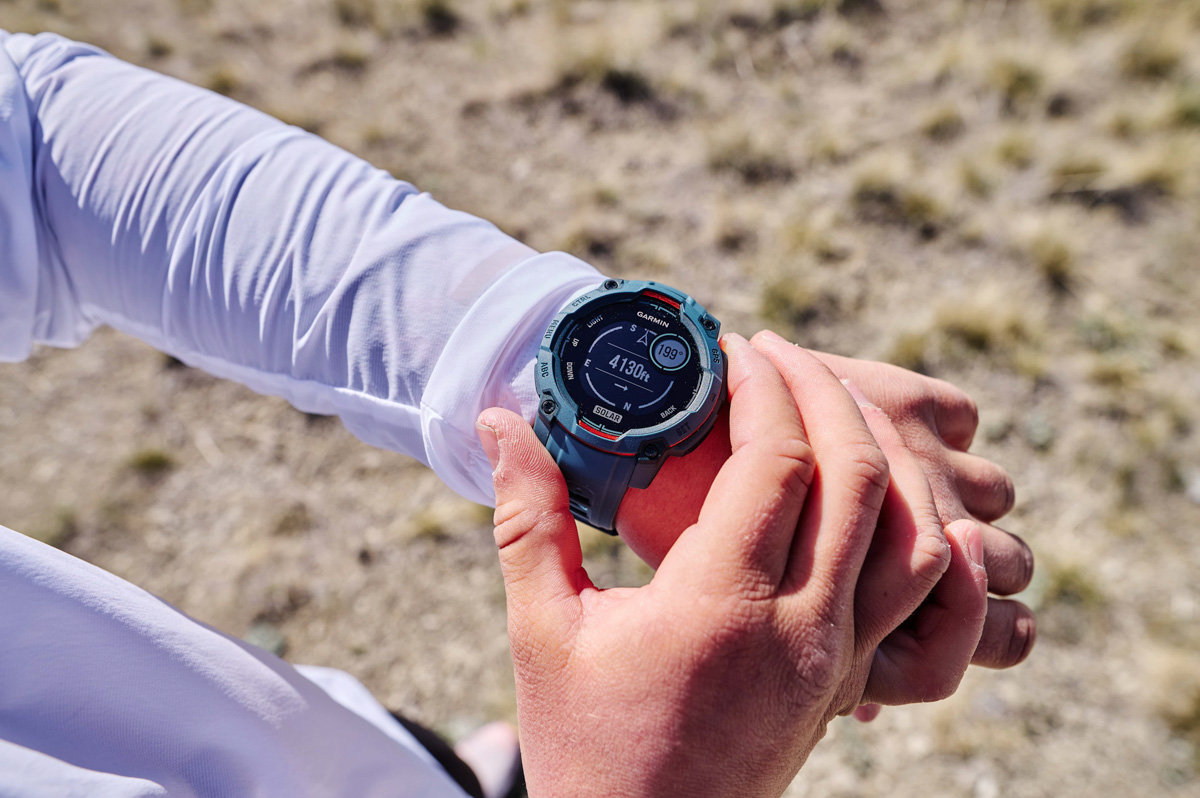
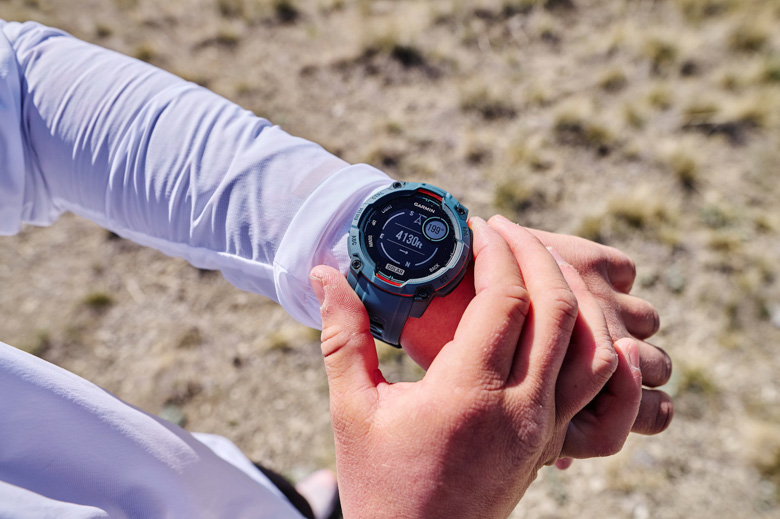
Price: $400
Weight: 1.8 oz.
Battery: Lithium-ion and solar
Diameters: 40mm, 45mm, 50mm
What we like: An accurate and fully-featured GPS watch with a tactical vibe, long battery life, and competitive price.
What we don’t: No detailed mapping or navigation; comes with a steep learning curve.
See the Garmin Instinct 3 Solar
The Instinct 3 is the latest addition to Garmin’s venerable Instinct line, and while it preserves the series’ no-frills, tactical vibe, it boasts a number of important upgrades from the previous 2. Most notably, the Instinct 3 Solar has an even longer battery life and an improved SatIQ GPS chipset. After testing this GPS watch extensively on a range of outdoor missions, I can confidently say it delivers in terms of activity, GPS capabilities, and health tracking. While it doesn’t have the most premium build quality or mapping and navigation of Garmin’s offerings—for that we turn to the Fenix series—this watch has proven more than enough for all of my frontcountry and most of my backcountry adventures. And it comes at a competitive price to boot. Below, I detail my experiences with the Garmin Instinct 3. For a wider view of the market, see our guides on the best GPS watches and best fitness watches.
As GPS watches continue to evolve, their battery life only seems to be getting better, and the Garmin Instinct 3 Solar is a case in point. This watch lasts up to 40 hours when tracking with standard GPS, which is about 10 hours longer than the previous Instinct 2. But things get really impressive when you consider its solar charging capabilities: Though both versions are equipped with solar charging, the Instinct 3 features a new and improved solar layer which bumps battery life from 48 hours when using standard GPS in the Instinct 2 to 130 hours in the 3. What’s more, in theory, if the Instinct 3 is only used in Smart Watch or Expedition Mode (neither of which use GPS), the solar charging maintains an unlimited battery life. This is a big deal for dedicated backcountry explorers who spend more than just their weekends out in the wilderness.
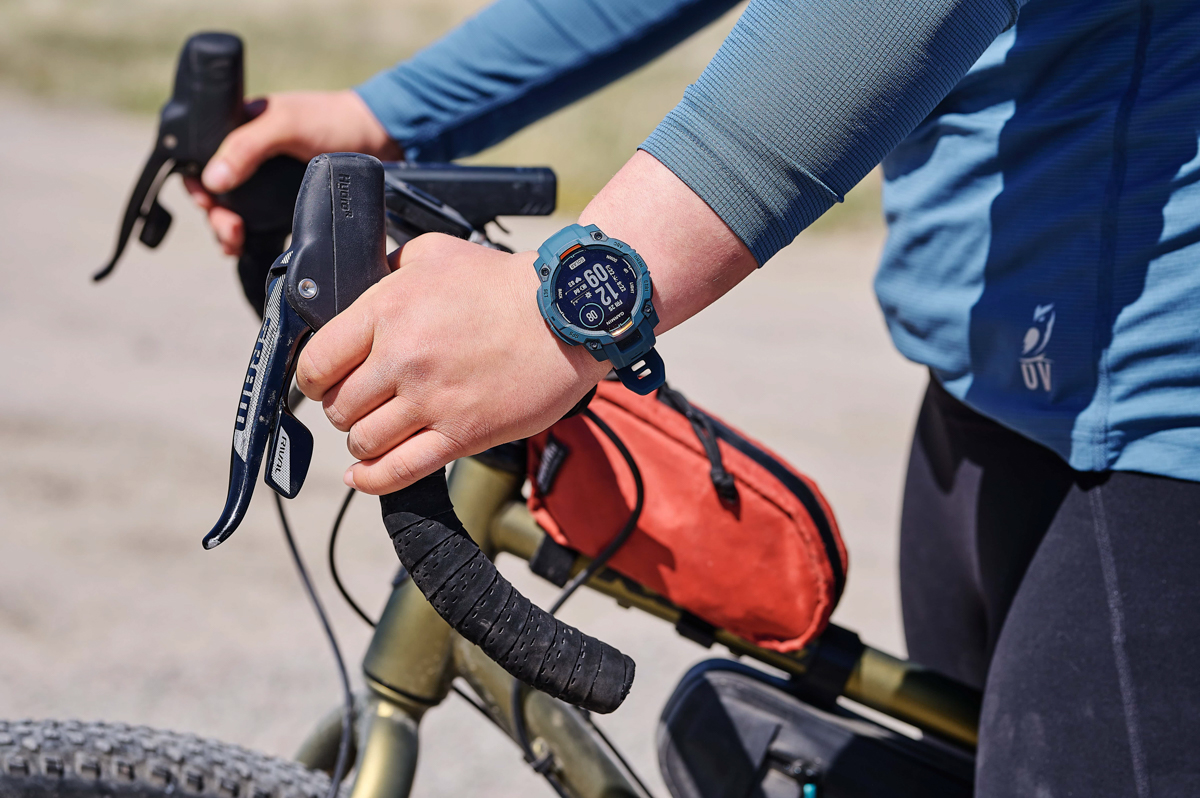
That said, my experiences differed a bit in testing. On average, I got about a week of regular use out of each full charge. My regular use included tracking daily workouts, sleep, and one longer activity such as a day hike or long run. And since my testing mostly occurred in the winter, I didn’t get much use out of the solar charging. Most of the time I wore long sleeves or gloves over the watch. In order to test the solar charging, I had to spend dedicated time in the sun, which was somewhat difficult to do in practice. I did play around with customizing the power modes to get more life out of my watch, which helped a bit in extending the life beyond a week.
The Instinct 3 also comes with an updated GPS chipset that uses SatIQ, which determines the best GPS mode depending on your environment. In open environments where the sky isn’t blocked by trees or buildings, SatIQ defaults to standard GPS to save battery life, but in enclosed environments, it would switch to all-systems or dual-frequency GPS to improve accuracy. In practice, I found the GPS accuracy to be fairly accurate. For the most part, the recorded tracks were identical to the track I created ahead of time. When following “out and back” tracks, the out and the back were only ever about 0.05 miles off from each other.

That said, the watch had some issues connecting to GPS satellites at times. When approaching a climb in the North Cascades, the Instinct 3 couldn’t find GPS in the forest, but then connected once I had a clearer view of the sky. As such, my track of the way up and way down were different, even though I took the same path either way (2.7 miles on the way up and 2.5 miles on the way down after GPS connected right away). While this problem was a bit annoying at times, it wasn’t a dealbreaker for me.
While wrist-based heart rate monitors are never as accurate as chest monitors, the Instinct 3 proved to have a surprisingly accurate reading most of the time. It was only ever a few beats her minute (bpm) off from my manual readings. On occasion, the watch would be slow to detect an increase in heart rate (especially a rapid increase) such as at the start of an activity or when climbing a steep hill. That said, once the heart rate sensor caught up, it stayed with me. I could see this being an issue during interval workouts, but for continuous endurance activities, this didn’t bother me too much.
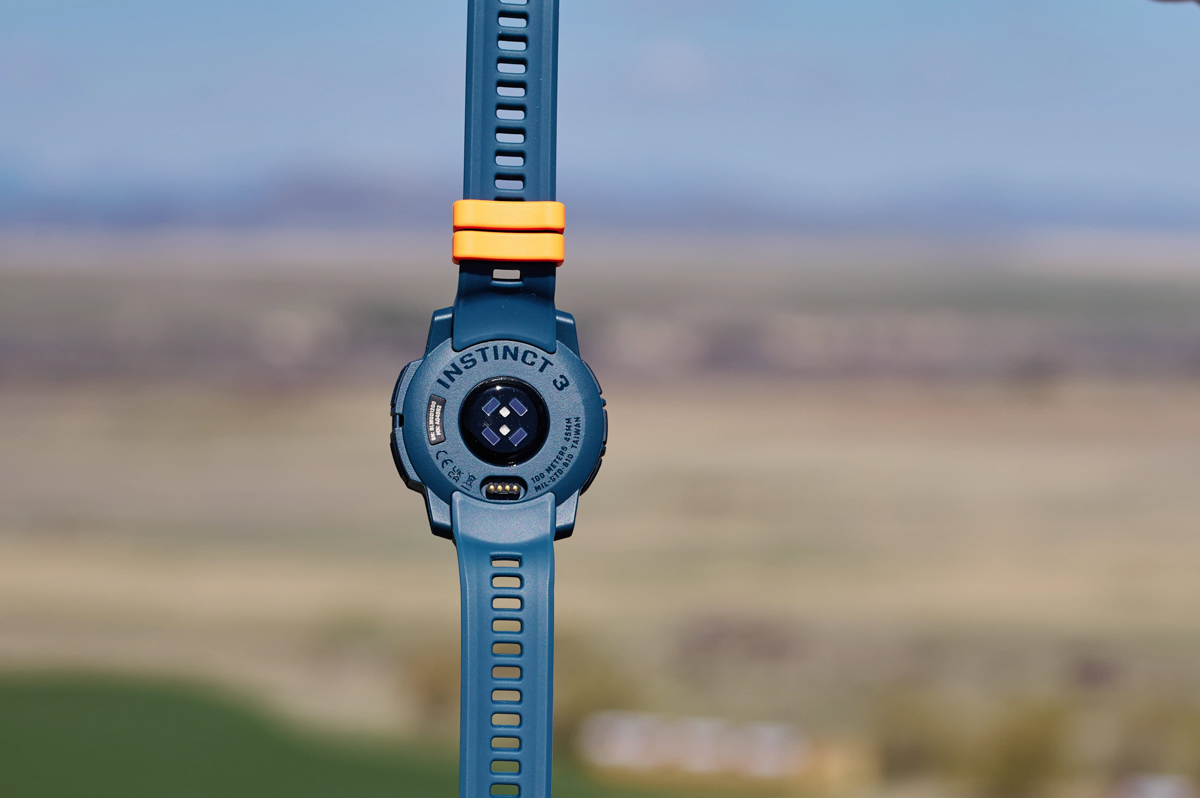
The Instinct 3 has over 75 pre-loaded activities, as well as the ability to create custom activities. In testing, I mostly used the running, biking, hiking, and climbing activities. You also get the ability to narrow down exactly the type of activity you want to record. For instance, under the outdoor running activity, you can pick between outdoor track running, trail running, and obstacle racing. There is a pretty even split between frontcountry and backcountry activities as well. For example, you can track HIIT workouts as well as backcountry skiing, pilates, and bike touring. For this reason, I never found the need to create a custom activity.

Each activity tracks and displays certain data. Most common among the modes I used were distance traveled, elevation gain and loss, and heart rate. Some activities also displayed data for VO2 Max and HRV (heart rate variability) status. The watch also gives an estimated recovery time and training load. Gym activities can be customized to help you stay on track during a workout, and Garmin offers recommended workouts for running and cycling. I got a kick out of the rucking activity because I was able to input the weight of my pack and the watch calculated my training intensity. It’s worth pointing out that you can customize the data screens for each activity, so you can be sure you have access to the data that matters the most to you. And if you’re doing more than one activity in a single session, you can swap between activities without pausing the recording to create a multisport activity.
While Garmin now offers the Instinct 3 with an AMOLED display, the solar versions are still limited to a monochrome display. This restricts the watch to either a navy or white display, but I liked that it made the watch easy to read in bright light and low light conditions. Like most Garmin watches, it took me a while to become familiar with the Instinct 3’s interface. Not only are there endless customization options, activities, and data screens to get used to, but it took me a while to become fluent with navigating the watch via its side buttons (note: the Instinct 3 doesn’t have a touchscreen), which each perform different tasks depending on how many times or how long they're pressed. Simply put, the user manual was my best friend for the first couple of weeks of testing.
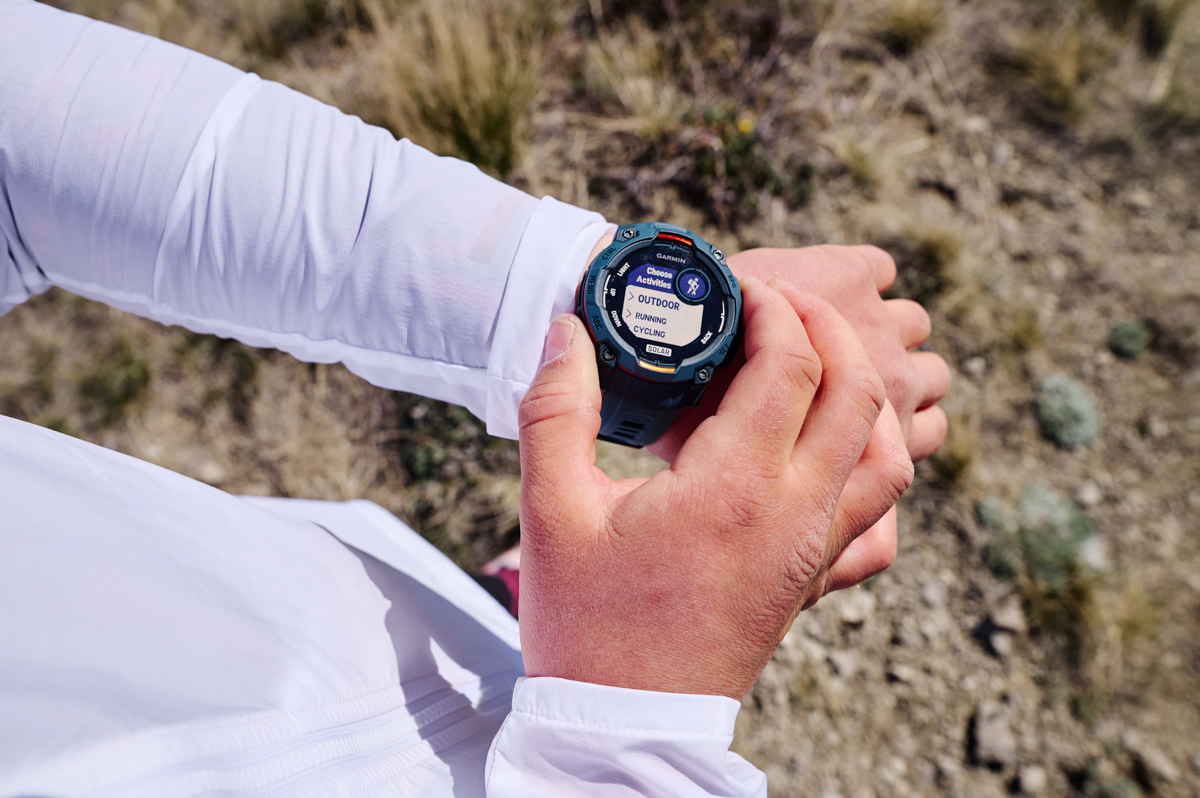
Compared to Garmin’s Fenix series, the Instinct 3 has fairly basic maps and breadcrumb navigation. Like the Fenix, you can upload your tracks to the watch through the Garmin Connect, Garmin Trails, and Garmin Explore apps (you have to pay for preexisting routes through the Trails and Explore apps, so I didn’t test this feature). However, uploading the track doesn’t get you a detailed map like it does with the Fenix. Instead, the watch displays a path on a simple map consisting of grid lines, city names, and previously saved locations. The watch provides turn-by-turn instructions as well as a deviation warning through its speaker, which is a nice touch. Though, without offline mapping, the Instinct 3 can’t help you get back on track if you stray.

If detailed maps matter to you, you can follow your course on a map on the Garmin Explore phone app (I prefer Gaia over Garmin's app, personally). There’s also a Sight ’N Go feature that could come in handy in certain situations: When selected, the watch gives you a straight line to follow to your desired destination. While I didn’t get to test this in a real-world situation, I could see it being especially helpful in white-out or water activities where it's tougher to keep a straight track.
Like most modern fitness watches, the Instinct 3 offers sleep tracking. So long as you don’t mind wearing such a big watch to bed, the watch will track how much time you spend in each sleep zone (light, deep, REM, and awake) as well as your overnight HRV. The watch also provides a sleep score every morning based on the measurements from the previous night. It’s tough to say if the sleep tracking is truly accurate or not, and the jury’s still out on whether any wrist-based sensors can accurately track sleep data in the greater health and fitness space. But it’s still a handy feature if you want to get at least a general idea of your sleep patterns.
The Instinct 3 is also the first of the Instinct series to have a flashlight. It seems like it’s best reserved for emergency situations, however. It’s not super bright and it drains the battery quickly. But it’s a nice feature for finding something in the tent in the middle of the night. Also note that the brightness can be adjusted and there is also a red light mode that’s nicer on the eyes at night.

The full list of features offered by the Instinct 3 are plentiful and can be found on Garmin's site, but there are a few notable ones to mention here. I found the ABC (altimeter, barometer, and compass) features helpful when in the backcountry, especially the storm alert, which lets users know when a storm is rolling in. The sunrise and sunset times are also helpful during all-day missions. On the daily use end, the Instinct 3 offers Garmin pay (which is a contactless payment similar to Apple Pay), Garmin Coach (which gives you recommended activities based on your previous activities), body battery (which pulls data from activities, sleep tracking, and stress levels to give you an idea of your lasting energy levels), and menstrual cycle tracking. The Instinct can also be set up to receive phone notifications on the watch and control music accessed through the connected phone.
Considering its relatively reasonable price point, it comes as little surprise to see that the Instinct 3 has a power glass lens and polymer/aluminum bezel. For reference, Garmin’s more premium (and pricier) Fenix watches have sapphire glass lenses and titanium bezels. That’s not to say that the Instinct 3 is prone to damage by any means. After months of consistent use, the watch has nary a scratch or dent to show for it, even after accidentally hitting it against rocks on many occasions. All buttons also perform as well as they did out of the box. I’ve had problems with the durability of silicone wrist bands on other watches I’ve tested, but the one the Instinct 3 came with has proven tough so far. Overall, I’m impressed with how well this watch has held up to regular testing, and I don’t doubt that it will last a long time to come.

I tested the Instinct 3 Solar, but Garmin offers a few variations of the watch. As aforementioned, the Instinct 3 is also available with a premium AMOLED display, but at the cost of solar charging and a bit of cash. You can also get either the solar or AMOLED versions in a military-standard tactical edition for about $100 more. The Tactical editions have a slightly different display and dedicated tactical features like stealth mode, a jumpmaster activity, and waypoint projection. If price is a concern, the Instinct E is available for about $100 less than the 3 Solar, but it has a more streamlined interface that foregoes solar charging (battery life is also shorter), dual-frequency GPS, a flashlight, Garmin Pay, and some health metrics. The E is also the only one of the Instinct series to be available in the smallest 40 millimeter size. The others are available in 45- and 50-millimeter sizes, except for the AMOLED Tactical, which is only available in 50 millimeter.

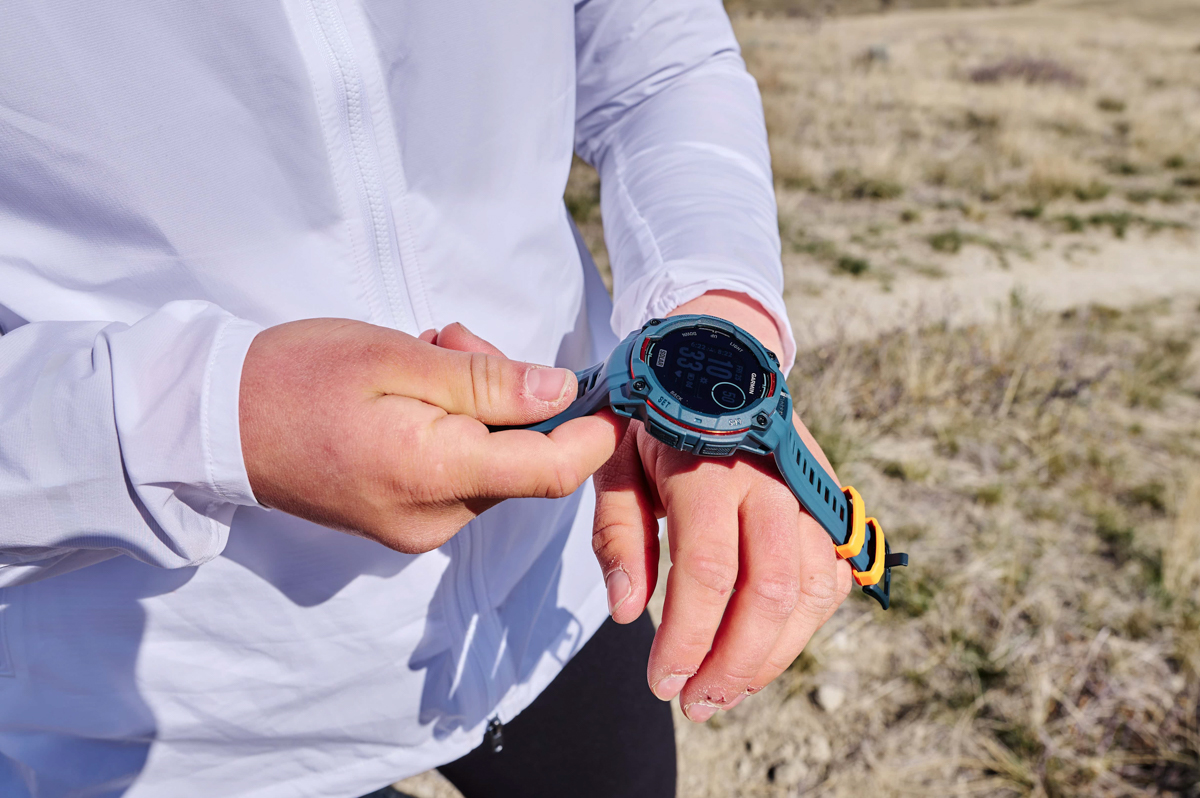
| Watch | Price | Weight | Battery* | Solar | Diameter(s) | Materials |
|---|---|---|---|---|---|---|
| Garmin Instinct 3 Solar | $400 | 1.8 oz. | 28 days | Yes | 40, 45, 50mm | power glass/polymer |
| Garmin Fenix 8 Solar | $1,100 | 2.8 oz. | 21 days | Yes | 43, 47, 51mm | sapphire/titanium |
| Coros Pace 3 | $229 | 1.4 oz. | 15 days | No | 41.9mm | polymer/mineral glass |
| Coros Nomad | $349 | 2.2 oz. | 22 days | No | 47.8mm | polymer/mineral glass |
*Editor’s note: The stated battery life is the manufacturer’s claim while in default smartwatch mode (without solar charging). Changes to the settings, features, and type of tracking will affect this number.
The Instinct 3 boasts a tough-to-beat combination of price, performance, and durability, but there are plenty of options on the market to consider. From within Garmin's ecosystem, the Fenix series watches are a sizable upgrade from the Instinct 3. In the latest Fenix 8 Solar you get detailed offline mapping and navigation, a slightly more impressive battery life (149 hours when using standard GPS and solar charging), and a more durable Sapphire Glass and titanium construction. The Fenix 8 also has more activities, ECG and Afib sensors, and some other smaller additional features like voice commands. That said, the Fenix 8 comes at a gasp-worthy price: over $1,000 at the time of publishing. Dedicated backcountry travelers who depend on maps and navigation on the trail (or on the bushwhack) might find the upgrade worth the price, but in our opinion, the Instinct 3 is more than enough for most weekend warriors and backcountry dabblers.

The Coros Pace 3 and Nomad watches come closer to the Instinct 3 with their intentions and price points. The Pace 3 is the more budget of the two options, and it has a fairly limited interface to match. Like the Instinct 3, it has breadcrumb navigation, a less-than-premium construction (mineral glass lens and polymer bezel), and a modest number of sensors and activity modes (the Instinct 3 has it beat by a bit here). You also sacrifice a lot of battery life in going with the Pace 3. It lasts just 38 hours tracking in standard GPS and doesn’t have solar charging. Coros’s newest Nomad is the Instinct 3’s closest rival with a number of backcountry-ready features like detailed offline mapping, backcountry-specific activity tracking (like mountaineering, climbing, and fishing), and a similar tactical vibe. Again, the Instinct 3 has the Nomad beat with battery life—the Nomad lasts 50 hours when tracking in all-systems GPS and doesn’t have solar charging. So if you plan on spending any extended periods of time away from a charger, the Instinct 3 is the clear choice.
Back to the Garmin Instinct 3 Solar Review See Our GPS Watch Guide